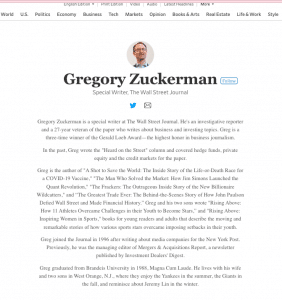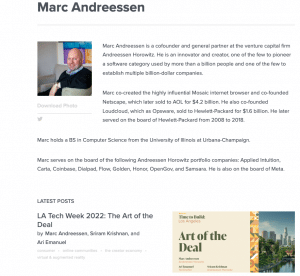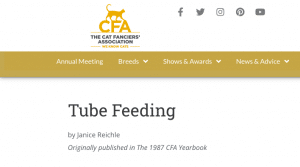Blog author pages 101: Why you need one and how to craft a winning bio

An author page is a dedicated section of your website that showcases information about a specific author or contributor. This page typically includes a bio, a profile picture, a list of published articles and other relevant information, such as social profile links.
As a B2B industry leader, it’s vital to establish your web presence to connect with your audience, build credibility and grow your influence. And creating a blog author page for your thought leadership and educational content is one way to achieve these professional goals and increase your site’s perceived value.
At Productive Shop, we recommend that our B2B SaaS clients have individual author pages for all leaders and team members who output content. So, let’s explore why blog author pages are an essential element of your website and how they can help boost your search engine optimization (SEO) results. In this post, we also share examples of optimized author bios to get you started.
Are author bios important?
Google has confirmed that author pages are not a direct ranking factor. So do author bios have any significance and should you prioritize them?
The short answer is yes. SEO is all about the value of expertise, authority and trust (E-A-T) in improving search engine visibility for your content. In fact, Google’s quality rater guidelines (QRG) — a guide to create a consistent standard for third-parties to rate the quality of a site — encourage raters to check for the author, their biography and credentials when determining the value of a piece of content.
So, while author bios may not directly be a part of search engines’ algorithm considerations, John Mueller — Google’s Search Advocate — says they can be valuable for user experience.
Here are three reasons why author pages are important for your brand:
- An author page with a well-written bio can help establish your expertise and authority in your niche. Imagine that two websites in the same industry publish articles on the same topic with two competing opinions. In determining which article is more authoritative, web users will consider the legitimacy of each writer. The author, whose bio seems more robust and who users recognize from other locations — such as social media, webinars and events — will earn trust quickly.
- Search engines like Google often crawl author pages, so having one can increase the visibility of your website and improve its ranking in search results. Since search engines consider author bios in assigning value to people, domains that host the content of an authoritative writer will rise in ranking because Google ranks what users find helpful. And users will read, recommend and return to the content of an established authority.
- Blog author pages provide a platform for writers to connect with their audience. By showcasing information about your staff writers, you can establish a relationship with readers, leading to increased engagement and a loyal following.
Sharing their individual experiences, users in a Moz content forum highlight that within a few months of adding author bios with certifications, degrees, employment history and experience spanning decades, their sites received a ranking boost.
How to write a killer bio to boost your “author SEO”
Now that we know that author bios help you build credibility and establish a connection with readers, these steps will help your team members with writing an author bio that sells:
- Write in the third person. Like a biography, an author page should be written from a third-party perspective and not from the subjects’ point of view.
- Define your objective. When building your author pages, it’s essential to start with a clear strategy in mind. Define your goals, target audience and unique value proposition, and use that information to guide the development of your web pages. While a writer can take on multiple roles, it is crucial to tailor each bio to the relevant industry.
- Cover the basics. A brief yet informative biography is the first step in creating a compelling author page. This section should give readers a sense of your staff’s role in the company. Include their names, title, professional headshot, education, experience and notable awards or achievements.
- Showcase expertise. This section is an opportunity to showcase your team’s success, knowledge and experience in the fielld. List any published work or accomplishments, even from before you met them. Feel free to include links where viewers can find them.
Best practices for author page optimization
Crafting a compelling author bio can be tasking, especially if you’re unsure of what a good one looks like. To help you write an engaging author bio, we’ve put together a list of tips that will guide you through the process and help you to create a bio that accurately represents you and your work.
Consider these tips in writing an author bio that showcases your expertise and helps you stand out:
- Keep it concise. A blog author bio — the short snippet about the writer at the end of each post — should be brief and to the point. Keep your bio between 50 and 150 words and make sure the information you include is relevant and concise. To avoid being penalized by Google for thin content, you also need to ensure that your dedicated author page has at least 250 words, which can be achieved by adding links to social profiles and listing the latest blog posts by the same author.
- Use a conversational tone. An author bio is a chance to connect with your audience on a personal level, so use a conversational tone to make your bio more approachable.
- Include a call to action. Encourage your audience to engage with your content by including a call to action in your bio. You could invite your audience to follow you on social channels such as LinkedIn, sign up for your newsletter or visit your website.
- Inject personal tidbits: Your author bio is a chance to let your personality shine through. Include personal details such as hobbies and interests to make your bio more memorable and relatable.
- Use real, actual names. Google uses reconciliation to recognize your team members online. So, avoid using nicknames as they may affect the credibility of your site and SEO.
- Avoid sloppiness. Refrain from using ineffective language or making grammatical errors. Also, avoid overloading your bio with too much information as it affects readability.
- Keep it up-to-date. Regularly updating the author page with new titles, achievements or other news helps keep readers engaged and informed. Maintaining an active presence on the author page is vital to ensure that it remains relevant and interesting to visitors.
SEO author pages that rank: 8 actionable tips you can follow
SEO drives 1,000% more organic traffic than social media, according to a report by Brightedge research. And organic SEO traffic costs less than paid ads. Expanding your SEO efforts to include blog author pages is a great way to build authority within your industry.
To optimize your author bio for SEO, here are eight guidelines you can follow:
- Start by researching keywords related to your web page and the content you write. Use these keywords in your page title, headings and meta descriptions.
- Structure your content using header tags, such as H1 and H2, and keep your content unique, informative and relevant to your target audience. Need help tailoring your copy to search engines? Read our SEO writing guide.
- Use descriptive file names for author images such as professional headshots and write SEO-optimized alt tags.
- Include internal links to other pages on your site and citations to team members’ published works.
- Keep individual author pages on a separate URL that you can link to from short bios rather than one About Us page for all team members.
- Allow your author pages to be indexed by search engines as opposed to the common misconception of including a “no-index tag.”
- Use structured data — a specific group of text to help search engines understand the context of certain information and provide accurate results — such as schemas in JSON-LD format to support E-A-T.
- Add author URL in your article schema. In an official changelog in 2021, Google confirms that this URL property helps to disambiguate authors, which means to distinguish a writer from other researchers or authors on the web.
About the author: examples of winning bios to inspire you
Even though you can use different styles in presenting your team’s information, you should keep in mind that not all comply with author bio best practices.
At Productive Shop, we recommend that our B2B SaaS clients use the full bio.
The full bio
As the most descriptive, this bio includes an author’s name, professional headshot and a description following the best practices listed above. With a full bio, authors can differentiate themselves from others on the web, establish credibility and build an online presence within their industry.
See these quality author bio examples for inspiration:
Itai Damti from Unit
With a professional headshot, full name and job title, Itai’s bio gives insight into his work history and experience, highlighting the top companies he’s worked with. This bio also shares an opportunity to read more of his blog posts and guides.

Imran Selimkhanov from Productive Shop
Following best practices, Imran’s bio shares his role, experience, work history and hobbies. Readers can attach a face to the name and read other articles he’s written by clicking on his profile.

Gregory Zuckerman from Wall Street Journal
With a more lengthy bio on his dedicated author page and a shorter description on blogs, Gregory’s author bio highlights his extensive experience, published works, educational background and hobbies. Readers can immediately see more posts from him on this page.

Marc Andreesen from Andreessen Horowitz
From a brief description of his notable achievements and current roles to a social profile link, Marc’s bio does many things right.

What these author page examples do right
The examples above comply with author bio best practices:
- The author image is a professional headshot.
- The text is brief and concise.
- The bio highlights the author’s experience and expertise.
- The bio includes the real names of the subjects.
Author website bio styles to avoid
Some author bios are easy to craft but they don’t put your best foot forward and are not optimized for the best user experience.
Here are the two types of bios you should steer clear of when presenting your author information:
1. The bare bio
Short and consisting of the author’s name only, this type of bio leaves little room for readers to learn more about the writer and explore other posts.
The author of this tube feeding article has a name-only bio:

2. The partial bio
With just the author’s name, headshot — and sometimes, job title — this bio goes a step further than the bare bio but does not provide enough information about the writer to build authority and establish a connection with readers.
Here’s an example:

Let’s build optimized author pages for your team
Writing an author bio can seem like a simple task, but fitting your extensive career and wealth of experience into a few engaging sentences requires skill and precision.
Our team at Productive Shop can help you craft author pages that showcase your teams’ expertise and position your organization as an industry authority.
Looking to establish yourself as a thought leader in your field with author pages? Let’s have a chat.
Frequently asked questions
Where on my website should my author page be located?
The location of author bios on a website can vary depending on the purpose and design of the site.
However, common places to include author bios are:
- Blog posts. If you have a blog on your website, author bios can be placed at the end of each post to give readers more information about the writer.
- “About” or “team” pages. Many websites have dedicated pages that introduce the team behind the brand, where author bios can be included.
- Site footer. Some websites include a list of authors and their bios in the footer, which is accessible from every page on the site.
- Author archives. If your website has a section that showcases all the content written by a specific author, you can include their bio in this section.
Ultimately, the location of author bios on a website will depend on the design and goals of the site. Still, the most important thing is to make sure they are easily accessible and prominently displayed for visitors to read.
Do author pages need pictures?
Yes. Including optimized pictures in the blog author pages can make the bio more visually appealing and give visitors a face to associate with the name. Images also help to humanize the brand and make your organization more relatable to visitors.
Each bio picture should be a high-quality, professional headshot that accurately represents the author and fits within the overall style and tone of the website.
What to include in an author bio?
An author bio should include the details of the writer such as name, position at an organization, credentials, expertise and relevant experience. It’s also a good idea to include personal information such as hobbies and interests. Check out the author page examples above for inspiration.

Productive Shop Team
With diverse backgrounds and a shared enthusiasm for innovation and growth strategies, our passionate team of consultants brings together a wealth of experience and skills to meet the marketing and lead generation needs of B2B SaaS startups. Our seasoned writers, SEO specialists, project managers, designers and developers are always eager to share their knowledge and drive thought-provoking conversations.



